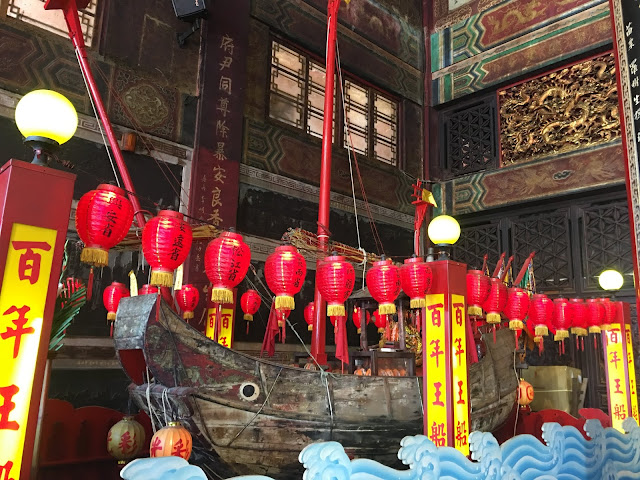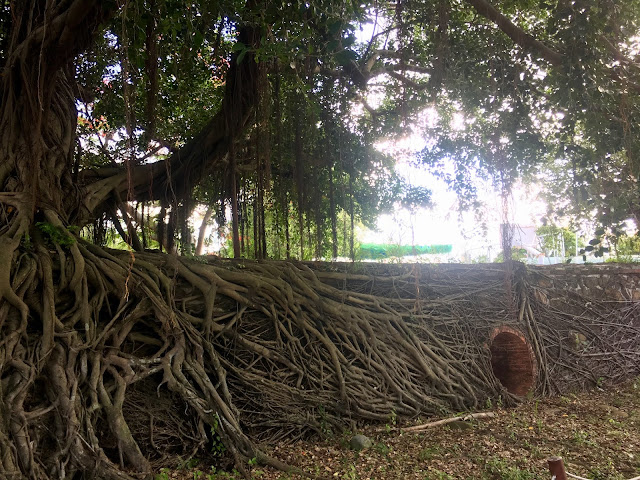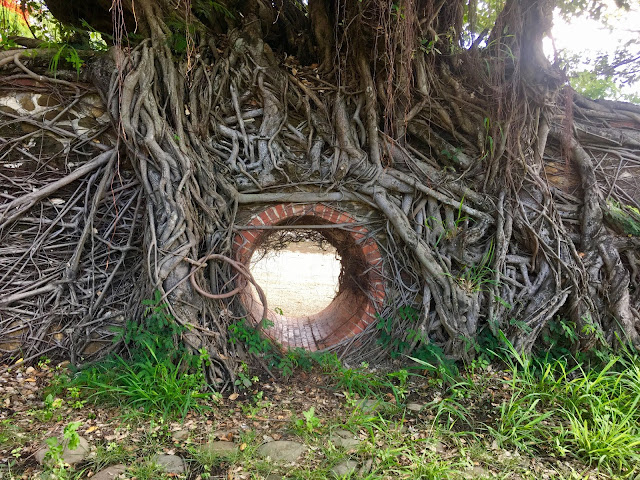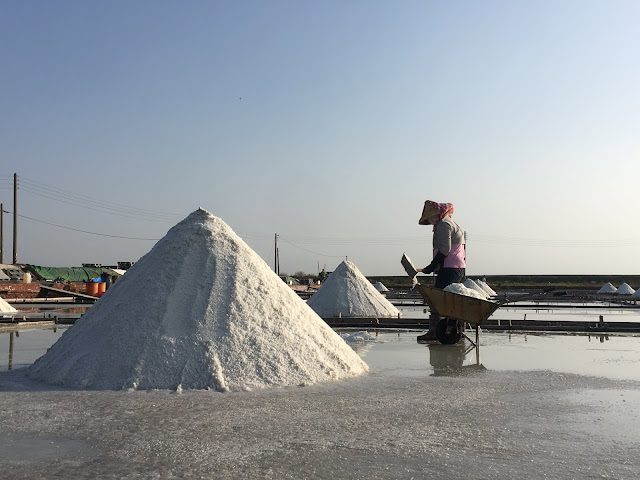Again, we traveled with my Polish friend and her family, and this time they wanted to visit Tainan. Initially, I wanted to go to Anping, but they chose to visit Taijiang National Park. We planned to take a boat trip, but there were too many people, and we would have had to wait for at least 1-2 hours. So, I decided to bring them to the Salt Fields instead. They had never been there before and really liked it. It's also a nice place for kids to play, as there are six fields that visitors are allowed to enter.
This wasn't our first time in the national park. Some time ago, we drove around the area. Without taking a boat trip, the view is not particularly special—just water with trees and some birds. We had also previously visited Sicao Fort and Luerhmen Mazu Temple, so I finally put it all together in one blog post.
Taijiang National Park (台江國家公園)
Taijiang National Park (台江國家公園) was officially established on December 28, 2009. It includes the Annan District of Tainan City and the coastal area of Qiqi District, including Sicao, Luermen, the former Anshun Yantian, the seven-share lagoon, and the sea to Dongji Island in Penghu County.
Unlike other national parks, which are primarily governed by the central government, Taijiang National Park was initiated by the local government, specifically the Tainan City Government. On June 29, 2009, the Ministry of the Interior approved a plan to establish the name "Taijiang River" to facilitate international marketing. Taijiang National Park covers an area of 39,310 hectares (118,912,754 ping).
Originally, the area was an inland sea and lagoon in southwest Taiwan until the 18th century when the lagoon gradually became land. The sandbar on the outer side of the lagoon integrated with the land. Additionally, the Taijiang River has played a significant role in history, with events such as Zheng Chenggong's entry into the Inner Sea through the Luermen Waterway and the unexpected attack on the earlier Dutch colonizers, establishing Taiwan as a dominant society for the Han people.
In 1624, the Dutch East India Company decided to relocate their destroyed Wuhu City to Taiwan and build a city on Daegu Island. After 8 years and 4 months, it was finally completed at the end of 1632. The city, serving as a trade and administrative center, was named Zeelandia, now known as "Anping Fort." In the opposite corner of the northern line (汕) tail island, the Dutch chose to build a walled city known as "Zeeburg." The structure was a three-story tower with the lower two floors measuring 6 meters wide and the upper floor 9 meters wide. It featured six cannons, and the wall was 2.5 meters thick. However, this town was damaged by a strong typhoon in 1656 and was never rebuilt, allowing Zheng Chenggong to take advantage of the situation. In 1661, Zheng Chenggong's army entered the Taijiang River through the Luermen Waterway, landing on the northern line.
Over time, due to siltation in the Luermen River and the development of land on both sides of the saltwater creek, the river channel narrowed, leading to a significant decrease in drifting sand. The construction of Wushantou Reservoir and Zengwen Reservoir further impacted the area. In recent years, the construction of the offshore fishing port and the multi-purpose port Anping Shanggang, as well as the burial of the Tainan Science and Technology Industrial Zone wastewater discharge pipe at the north side of the saltwater creek outlet, created a "jetty effect."
With changes in the environment and increasing labor costs, the aquaculture and salt industries faced challenges in the 1970s, leading Taiwan Salt to plan to stop salt production in the 1990s. The younger generation perceived farming as hard, risky, and unstable, resulting in a gradual abandonment of farming and the deterioration of fish farms. However, this decline in traditional coastal industries allowed the natural environment to recover, leading to a gradual diversification of biological ecology.
See also: Salt Fields and Salt Museum

Sicao Fort (四草砲臺)
Sicao Fort (四草砲臺) is located in the Annan District of Tainan City and is a second-class monument since August 1985. The building is one of the 17 turrets built by Yao Ying of the Taiwan Armed Forces during the Qing dynasty. The remaining part has become the small wall of Zhenhai.
To strengthen Taiwan's coastal defense during the first Opium War, Yao Ying of the Taiwan Armed Forces built Zhenhai City, commonly known as Sicao Fort, in 1840, alongside the construction of Anping Small Fort in Anping.
Due to the urgency of the defense at that time, the fortification was initially made of bamboo rafts and sacks, with a 30-foot (about 96-meter) long retaining wall and ten gun piers. The trench surrounding the fort was filled with 20,000 hidden bamboo sticks, 800 nail barrels, 800 nail boards, and two iron shovels.
However, after the garrison was transferred and the port of Sicao was abandoned, the fort fell into disrepair and was damaged. After World War II, in 1951, Zhenhai Elementary School was built on the west side of the remaining wall. The remaining section of the fort's wall became part of the school's outer wall. In 1969, a section of the wall collapsed due to a typhoon but was later restored in 1977.
The fort is constructed with pebbles, triple soil, and long slabs. The figure-shaped blastholes on the wall were designed to change the angle.
Opposite the fort is Sicao Temple, and behind the temple lies "Hailing Jiacheng," the remains of Dutch soldiers killed by Zheng Jun under the leadership of Chen Ze during the Dutch rule in Taiwan.
See also: Anping Fort
Salt Fields
I have been to the salt fields a few times, and it's always a wonderful experience. The sunset view here is truly beautiful. It's also a lot of fun for kids to play here. During this visit, there was even a parrot show, so we could see plenty of beautiful colorful birds flying above the fields. If you want to learn more about the salt history and salt fields, you can visit my other blog posts.
See also: Salt Fields and Museum of Salt
See also: Sio House - History of Salt
Luerhmen Mazu Temple (正統鹿耳門聖母廟)
Luerhmen Mazu Temple (正統鹿耳門聖母廟) is an Orthodox Temple in the Annan District of Tainan. It's a temple dedicated to the Virgin Mary. According to the book "Taiwan Tucheng Orthodox Luermen Temple," there was already a Mazu Temple in the area as early as Zheng Chenggong's arrival in Taiwan. At that time, there were three temples—one dedicated to Dianxian Zunwang in the front hall, one for the worship of Mazu in the Zheng Hall, and one for Buddha in the apse. Another story suggests that after Zheng Chenggong came to Taiwan, he rebuilt the temple to express his gratitude to God and added two side rooms to worship the three Mazu statues that came with the ship. After World War II, Xiangong built the temple's gate in 1947 and promoted the opening of the temple. In 1975, the temple was rebuilt at its current location.




















0 komentarze:
Post a Comment